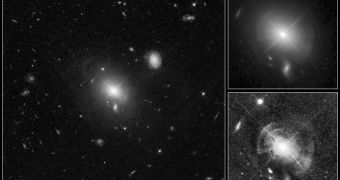NASA's Hubble space telescope has taken new images of an elliptical galaxy, about two billion light-years away from Earth, as part of a research project led by UC Riverside?s Gabriela Canalizo. The galaxy's center is dominated by a quasar. A super massive black hole sucks gas in, creating an accretion disk which is the prime source of energy of the quasar.
Not much is known about quasars, but it is thought to be a subclass of black holes which have large accretion disks, formed of extremely hot ionized gas, glowing brightly in the X-ray, infrared and visible light. They are the brightest objects in the universe. The observed galaxy is a result of a cosmic collision between two galaxies. This supports the idea that quasars need such galaxy merges to form.
Observations of the MC2 1635+119 galaxy show an older population of stars residing inside remnants of the old galaxies and many shells full of new stars, around its quasar. This supports the idea that this elliptical galaxy formed as a result of a collision, the shells being the result of strong tidal wave created by the galaxy's gravity. Eventually the gravitational pull on the stars will slowly let go and they will move away from the center.
This is the only transitional state ever seen after a galactic collision, meaning it must have had happened in the recent past. The scientists can not yet decide and have two possible scenarios for this merge. Two massive galaxies collided, or a massive galaxy and a smaller galaxy merged, but they still need high-resolution spectroscopic observation.
Estimates say that the collisions probably took place about 1.7 billion years ago and it triggered the birth of millions of new stars, such as those seen inside the shells surrounding the central quasar.
Recent studies show that quasars do not form only after galaxy collision, but they can also form on their own in old elliptical galaxies.

 14 DAY TRIAL //
14 DAY TRIAL //